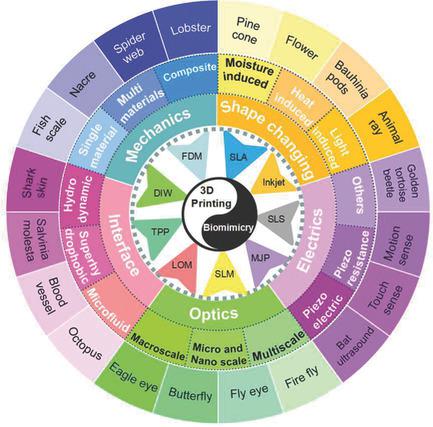当前位置:
X-MOL 学术
›
Adv. Mater.
›
论文详情
Our official English website, www.x-mol.net, welcomes your feedback! (Note: you will need to create a separate account there.)
Recent Progress in Biomimetic Additive Manufacturing Technology: From Materials to Functional Structures
Advanced Materials ( IF 29.4 ) Pub Date : 2018-06-19 , DOI: 10.1002/adma.201706539 Yang Yang 1 , Xuan Song 2, 3 , Xiangjia Li 1 , Zeyu Chen 4 , Chi Zhou 5 , Qifa Zhou 4 , Yong Chen 1
Advanced Materials ( IF 29.4 ) Pub Date : 2018-06-19 , DOI: 10.1002/adma.201706539 Yang Yang 1 , Xuan Song 2, 3 , Xiangjia Li 1 , Zeyu Chen 4 , Chi Zhou 5 , Qifa Zhou 4 , Yong Chen 1
Affiliation

|
Nature has developed high‐performance materials and structures over millions of years of evolution and provides valuable sources of inspiration for the design of next‐generation structural materials, given the variety of excellent mechanical, hydrodynamic, optical, and electrical properties. Biomimicry, by learning from nature's concepts and design principles, is driving a paradigm shift in modern materials science and technology. However, the complicated structural architectures in nature far exceed the capability of traditional design and fabrication technologies, which hinders the progress of biomimetic study and its usage in engineering systems. Additive manufacturing (three‐dimensional (3D) printing) has created new opportunities for manipulating and mimicking the intrinsically multiscale, multimaterial, and multifunctional structures in nature. Here, an overview of recent developments in 3D printing of biomimetic reinforced mechanics, shape changing, and hydrodynamic structures, as well as optical and electrical devices is provided. The inspirations are from various creatures such as nacre, lobster claw, pine cone, flowers, octopus, butterfly wing, fly eye, etc., and various 3D‐printing technologies are discussed. Future opportunities for the development of biomimetic 3D‐printing technology to fabricate next‐generation functional materials and structures in mechanical, electrical, optical, and biomedical engineering are also outlined.
中文翻译:

仿生增材制造技术的最新进展:从材料到功能结构
大自然在数百万年的发展中已经开发出高性能的材料和结构,并为下一代结构材料的设计提供了宝贵的灵感来源,这要归功于各种出色的机械,流体动力学,光学和电学特性。仿生学通过学习自然界的概念和设计原理,正在推动现代材料科学和技术的范式转变。然而,自然界中复杂的结构架构远远超出了传统设计和制造技术的能力,这阻碍了仿生研究的进展及其在工程系统中的使用。增材制造(三维(3D)打印)为操纵和模仿本质上多尺度,多材料,自然界中的多功能结构。在此,提供了仿生增强力学,形状更改和流体力学结构以及光学和电气设备的3D打印最新进展的概述。灵感来自各种生物,例如珍珠母,龙虾爪,松果,花朵,章鱼,蝴蝶翅膀,蝇眼等,并讨论了各种3D打印技术。还概述了仿生3D打印技术发展的未来机会,以制造机械,电气,光学和生物医学工程学中的下一代功能材料和结构。灵感来自各种生物,例如珍珠母,龙虾爪,松果,花朵,章鱼,蝴蝶翅膀,蝇眼等,并讨论了各种3D打印技术。还概述了仿生3D打印技术发展的未来机会,以制造机械,电气,光学和生物医学工程学中的下一代功能材料和结构。灵感来自各种生物,例如珍珠母,龙虾爪,松果,花朵,章鱼,蝴蝶翅膀,蝇眼等,并讨论了各种3D打印技术。还概述了仿生3D打印技术发展的未来机会,以制造机械,电气,光学和生物医学工程学中的下一代功能材料和结构。
更新日期:2018-06-19
中文翻译:

仿生增材制造技术的最新进展:从材料到功能结构
大自然在数百万年的发展中已经开发出高性能的材料和结构,并为下一代结构材料的设计提供了宝贵的灵感来源,这要归功于各种出色的机械,流体动力学,光学和电学特性。仿生学通过学习自然界的概念和设计原理,正在推动现代材料科学和技术的范式转变。然而,自然界中复杂的结构架构远远超出了传统设计和制造技术的能力,这阻碍了仿生研究的进展及其在工程系统中的使用。增材制造(三维(3D)打印)为操纵和模仿本质上多尺度,多材料,自然界中的多功能结构。在此,提供了仿生增强力学,形状更改和流体力学结构以及光学和电气设备的3D打印最新进展的概述。灵感来自各种生物,例如珍珠母,龙虾爪,松果,花朵,章鱼,蝴蝶翅膀,蝇眼等,并讨论了各种3D打印技术。还概述了仿生3D打印技术发展的未来机会,以制造机械,电气,光学和生物医学工程学中的下一代功能材料和结构。灵感来自各种生物,例如珍珠母,龙虾爪,松果,花朵,章鱼,蝴蝶翅膀,蝇眼等,并讨论了各种3D打印技术。还概述了仿生3D打印技术发展的未来机会,以制造机械,电气,光学和生物医学工程学中的下一代功能材料和结构。灵感来自各种生物,例如珍珠母,龙虾爪,松果,花朵,章鱼,蝴蝶翅膀,蝇眼等,并讨论了各种3D打印技术。还概述了仿生3D打印技术发展的未来机会,以制造机械,电气,光学和生物医学工程学中的下一代功能材料和结构。


























 京公网安备 11010802027423号
京公网安备 11010802027423号